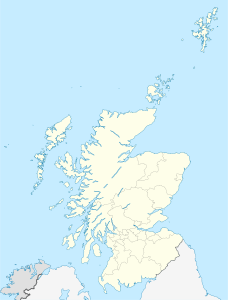Fingal's Cave
| Fingal's Cave
|
||
|---|---|---|
|
Fingal's Cave |
||
| Location: | Staffa , Scotland | |
| Height : | 23 m | |
|
Geographic location: |
56 ° 25 '53 " N , 6 ° 20' 28.8" W | |
|
|
||
| Geology: | basalt | |
| Discovery: | 1772 | |
| Overall length: | 85 m | |
Fingal's Cave ( Scottish Gaelic : Uamh-Binn ) is an 85 meter long cave on the uninhabited Scottish island of Staffa in the Inner Hebrides . It is for the most part surrounded by basalt columns that were created in the Tertiary . Alongside the Giant's Causeway in Northern Ireland , it is one of the most famous basalt formations in the United Kingdom.
history
Fingal's Cave was visited and described by Joseph Banks , an English naturalist, on an expedition to Iceland in August 1772 .
The cave is named after the legendary hero Fingal , who was invented by the Scottish writer James Macpherson . In his Fragments of Ancient Poetry, Macpherson had the fictional poet Ossian - based on the mythical Irish poet Oisín - report on the heroic deeds of King Fingal, whose model was the Irish warrior Fionn mac Cumhaill .
tourism
In the 19th century, Fingal's Cave was a tourist attraction; up to 300 tourists a day landed on Staffa to visit the cave. Famous visitors were Queen Victoria , Walter Scott , Felix Mendelssohn Bartholdy , John Keats , Theodor Fontane and William Wordsworth . The busy boat traffic to the island has largely ceased these days.
Martin Mills from the Grampian Speleological Group describes the cave as the most famous but least visited cave in the world (" most famous but least visited cave in the world "). He is alluding to the fact that although many ships and boats with tourists on board pass Staffa, only a few actually anchor there. Only a few smaller boats from Mull and Iona , the neighboring islands, still call at Staffa today.
Fingal's Cave in Art
On August 8, 1829, Felix Mendelssohn Bartholdy visited Fingal's Cave. Inspired by his stay, he composed the overture The Hebrides .
The romantic painter William Turner painted the entrance to the cave in 1832; he named the finished painting Staffa, Fingal's Cave (see section “Web Links”). It was named by the Royal Academy of Arts in London as one of the most perfect expressions of the romanticism style of art ("one of the most perfect works of romanticism"). Today the painting is in the Yale Center for British Art in New Haven . The German doctor, natural scientist and romanticist Carl Gustav Carus painted the view from the Fingals Cave by moonlight around 1851 ( Kupferstichkabinett Dresden , inv.no. C 1963-4).
The French author Jules Verne described in his novel The Green Ray , published in 1882, the visit of a tour group to Fingal's Cave. The dramatic climax of the novel is the overnight travelers in the cave while a hurricane rages outside. The first edition of the novel contains engravings by Léon Benett showing Fingal's Cave.
photos
Fingal's Cave on a photochromic print (around 1900)
Individual evidence
- ↑ Show Caves of the World ( Memento from May 25, 2006 in the Internet Archive )
- ^ Martin Mills: A Visit to the most famous but least visited Cave in the World. In: Grampian Speleological Group. Bulletin. Ser. 3, Vol. 3, No. 1, 1994, ISSN 0306-1698 , p. 9 ff. Mills uses “famous” to mean “often represented in the specialist literature”.
- ^ Dundee Satellite Receiving Station
- ^ Yale Center for British Art
- ↑ Petra Kuhlmann-Hodick, Gerd Spitzer, Bernhard Maaz (eds.): Carl Gustav Carus. Nature and idea. Deutscher Kunstverlag, Berlin 2009, ISBN 978-3-422-06880-3 .
Web links
- Information about the cave (English)
- William Turner: Staffa, Fingal's Cave (English)
- William Wordsworth: Cave of Staffa (English)
- Photos of the cave






